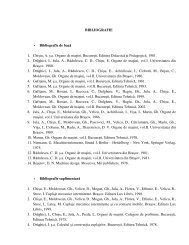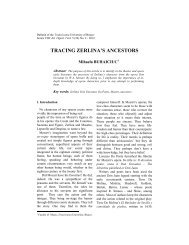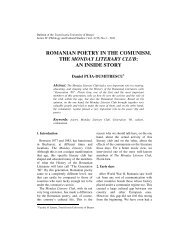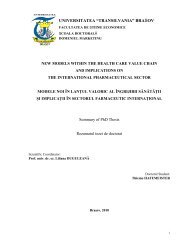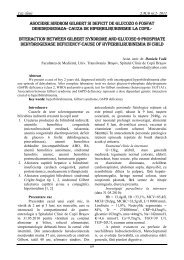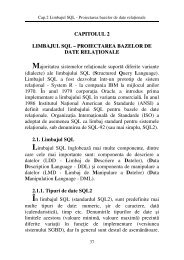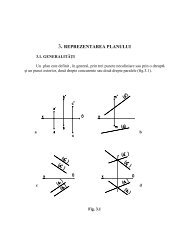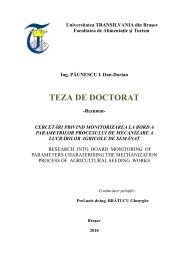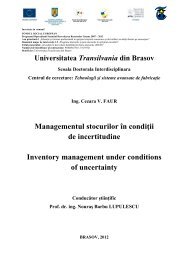investigating the hydraulic tappet rotation for a direct acting valve train
investigating the hydraulic tappet rotation for a direct acting valve train
investigating the hydraulic tappet rotation for a direct acting valve train
Create successful ePaper yourself
Turn your PDF publications into a flip-book with our unique Google optimized e-Paper software.
Bulletin of <strong>the</strong> Transilvania University of Braşov<br />
Series I: Engineering Sciences • Vol. 5 (54) No. 1 - 2012<br />
1. Introduction<br />
INVESTIGATING THE HYDRAULIC<br />
TAPPET ROTATION FOR A DIRECT<br />
ACTING VALVE TRAIN<br />
L. JELENSCHI 1 C. COFARU 1 G. SANDU 1<br />
Abstract: The paper presents <strong>the</strong> research regarding <strong>the</strong> <strong>rotation</strong>al<br />
movement of a <strong>hydraulic</strong> <strong>tappet</strong> from a <strong>direct</strong> <strong>acting</strong> <strong>valve</strong> <strong>train</strong> system.<br />
Firstly <strong>the</strong> advantages and disadvantages of <strong>the</strong> <strong>tappet</strong> <strong>rotation</strong> during<br />
engine functioning are described. Then, a description of <strong>the</strong> virtual model of<br />
<strong>the</strong> <strong>direct</strong> <strong>acting</strong> <strong>valve</strong> <strong>train</strong> modeling process is made and <strong>the</strong> parameters<br />
that influence <strong>the</strong> <strong>rotation</strong>al movement are presented. The results obtained<br />
with <strong>the</strong> virtual model are presented in comparison with <strong>the</strong> experimental<br />
results obtained by o<strong>the</strong>r authors. The conclusions revealed that <strong>the</strong> position<br />
of <strong>the</strong> camshaft, <strong>the</strong> engine speed and <strong>the</strong> friction coefficient have a<br />
significant influence on <strong>the</strong> <strong>hydraulic</strong> <strong>tappet</strong> <strong>rotation</strong>.<br />
Key words: <strong>direct</strong> <strong>acting</strong> <strong>valve</strong> <strong>train</strong>, <strong>tappet</strong> <strong>rotation</strong>, dynamic analysis, wear.<br />
The analysis of <strong>the</strong> <strong>valve</strong> <strong>train</strong> system is<br />
very important because it influences <strong>the</strong><br />
gas exchange process and <strong>the</strong> engine<br />
per<strong>for</strong>mance. The main role of this system<br />
is to ensure a suitable filling of engine<br />
cylinders with gasoline-air mixture <strong>for</strong><br />
spark ignition engines or with air <strong>for</strong><br />
compression ignition engine. Also it must<br />
ensure a good cylinder sealing during each<br />
cycle [1], [7].<br />
Considering those aspects a few types of<br />
<strong>valve</strong> <strong>train</strong>s were developed. The most<br />
common type is <strong>the</strong> <strong>direct</strong> <strong>acting</strong> OHC<br />
<strong>valve</strong> <strong>train</strong> because it’s simple<br />
configuration, small number of<br />
components and its high stiffness at high<br />
engine speeds. The main inconvenience of<br />
this type of <strong>valve</strong> <strong>train</strong> is due to high<br />
friction loses during functioning which<br />
1 Dept. High Tech Products <strong>for</strong> Automobiles, Transilvania University of Braşov.<br />
entails a massive wear [5], [8], [12], [14].<br />
An analysis of <strong>the</strong> <strong>tappet</strong> <strong>rotation</strong> is<br />
important because it is known <strong>the</strong> fact that<br />
friction loses because of <strong>the</strong> <strong>valve</strong> <strong>train</strong><br />
represent almost 21% from entire engine<br />
friction loses. So if <strong>the</strong> <strong>tappet</strong> rotates <strong>the</strong><br />
value of <strong>the</strong> friction loses decrease<br />
significant [6], [8-10].<br />
Also <strong>the</strong> <strong>tappet</strong> <strong>rotation</strong> ensures a<br />
uni<strong>for</strong>m film of oil between cam and<br />
<strong>tappet</strong> and <strong>the</strong> contact area is always<br />
different determining a uni<strong>for</strong>m wear of<br />
<strong>tappet</strong> surface [11].<br />
Fig. 1. Different types of <strong>tappet</strong> wear [8]
14<br />
Bulletin of <strong>the</strong> Transilvania University of Braşov • Series I • Vol. 5 (54) No. 1 - 2012<br />
As seen in Figure 1, <strong>the</strong> wear of <strong>the</strong><br />
<strong>tappet</strong> is due to <strong>the</strong> cam contact <strong>for</strong>ce. If<br />
<strong>the</strong> <strong>tappet</strong> doesn’t rotate <strong>the</strong>n <strong>the</strong> cam acts<br />
on <strong>the</strong> same place causing <strong>the</strong> apparition of<br />
an unwanted phenomenon known as<br />
pitting. Also surface damages it might<br />
appear as a result of abrasive wear.<br />
Ano<strong>the</strong>r unwanted phenomenon is <strong>the</strong><br />
local welding between cam and <strong>tappet</strong> due<br />
to <strong>the</strong> lack of lubrication and <strong>the</strong> <strong>the</strong>rmal<br />
stresses [3], [4].<br />
After a literature study, it was concluded<br />
that several authors have analyzed <strong>tappet</strong><br />
<strong>rotation</strong> on different test bench configuration.<br />
Some of <strong>the</strong>m used optical fiber and<br />
phototransistor placed under <strong>the</strong> <strong>tappet</strong> <strong>for</strong><br />
measuring <strong>the</strong> <strong>rotation</strong>al movement. O<strong>the</strong>rs<br />
used a dangerous method to measure this<br />
motion by placing radioactive marker on<br />
<strong>tappet</strong> surface. The newest method is<br />
represented by <strong>the</strong> using of eddy current<br />
sensor placed in front of <strong>the</strong> <strong>tappet</strong> surface<br />
on which a gap was machined [6].<br />
In all those cases, <strong>the</strong> numbers of <strong>tappet</strong><br />
<strong>rotation</strong> were measured and after that <strong>the</strong><br />
<strong>tappet</strong> <strong>rotation</strong> speed was determined as<br />
seen in Figure 12.<br />
Concluding this, we realize that is very<br />
important to know how many degrees and<br />
in which side <strong>tappet</strong> rotates. To solve this<br />
problem a 3D model of <strong>the</strong> <strong>direct</strong> <strong>acting</strong><br />
<strong>valve</strong> <strong>train</strong> was created.<br />
2. Configuration of <strong>the</strong> Valve Train<br />
If we analyze <strong>the</strong> <strong>direct</strong> <strong>acting</strong> <strong>valve</strong> <strong>train</strong><br />
we observe that <strong>the</strong> main motion of <strong>the</strong><br />
<strong>tappet</strong> is <strong>the</strong> translational movement. But<br />
because of <strong>the</strong> <strong>tappet</strong> and <strong>tappet</strong> guide<br />
configuration looks like a cylinder, <strong>the</strong><br />
<strong>tappet</strong> may have an additional movement:<br />
<strong>the</strong> <strong>rotation</strong> across its own symmetrical<br />
axis [2-4].<br />
To obtain <strong>the</strong> <strong>tappet</strong> <strong>rotation</strong> <strong>the</strong> cam is<br />
placed with a slight offset from <strong>the</strong><br />
symmetrical axis of <strong>the</strong> <strong>tappet</strong> as can be<br />
seen in Figure 2.<br />
Fig. 2. Cam/flat-faced <strong>tappet</strong> contact [11]<br />
If <strong>the</strong> <strong>tappet</strong> is with spherical top surface,<br />
see Figure 3, <strong>the</strong>n <strong>the</strong> cam profile is<br />
manufactured with a small angle α <strong>for</strong><br />
ensure an offset contact and to determine<br />
<strong>the</strong> <strong>tappet</strong> to rotate.<br />
Fig. 3. Contact between cam and a<br />
spherical surface <strong>tappet</strong> [11]<br />
Both solutions described above determine<br />
sideways movement of <strong>the</strong> contact zone.<br />
This causes a <strong>rotation</strong>al torque to <strong>the</strong> axis<br />
of symmetry of <strong>the</strong> <strong>tappet</strong>, which tends to<br />
rotate <strong>the</strong> <strong>tappet</strong>.<br />
Considering those affirmation we might<br />
conclude that <strong>the</strong> <strong>tappet</strong> <strong>rotation</strong> is<br />
influenced by <strong>the</strong> cam/<strong>tappet</strong> contact <strong>for</strong>ce<br />
and by <strong>the</strong> friction coefficient between<br />
those two surfaces. Also, <strong>the</strong> friction<br />
between <strong>tappet</strong> and its guide and <strong>the</strong> lateral<br />
<strong>for</strong>ces that appear during <strong>tappet</strong> rolling as a<br />
result of <strong>the</strong>rmal gap, are to be considered.<br />
O<strong>the</strong>r author reveals that <strong>the</strong> lubrication<br />
film thickness and oil viscosity and<br />
temperature, influence significantly <strong>the</strong><br />
<strong>tappet</strong> <strong>rotation</strong>. The <strong>tappet</strong> rotates faster<br />
when oil has a high temperature and its
Jelenschi, L., et al.: Investigating <strong>the</strong> Hydraulic Tappet Rotation <strong>for</strong> a Direct Acting Valve Train 15<br />
viscosity is low. The same phenomenon<br />
happens when <strong>the</strong> oil pressure increases [6].<br />
3. Virtual Model of <strong>the</strong> Valve Train<br />
Based on <strong>the</strong> previous claims a 3D<br />
model of <strong>the</strong> <strong>direct</strong> <strong>acting</strong> <strong>valve</strong> <strong>train</strong> was<br />
created using Virtual Lab Motion software<br />
from LMS.<br />
The components dimensions and masses<br />
were measured from a SAAB 900 cylinder<br />
head. After that <strong>the</strong> 3D bodies were created<br />
using Catia V5R16 software, Figure 4.<br />
The next step was to create <strong>the</strong> assembly<br />
of <strong>the</strong> <strong>valve</strong> <strong>train</strong> using different cons<strong>train</strong>s,<br />
joints and contact between components [5].<br />
Fig. 4. Section between 3D models of <strong>the</strong><br />
<strong>direct</strong> <strong>acting</strong> OHC <strong>valve</strong> <strong>train</strong> [2]<br />
In Figure 5 <strong>the</strong> links between <strong>valve</strong> <strong>train</strong><br />
components are presented. As it can be<br />
seen <strong>the</strong> camshaft bearings, <strong>valve</strong> guide,<br />
<strong>tappet</strong> guide and <strong>valve</strong> seat are fixed to <strong>the</strong><br />
ground. Also by a bracket joint <strong>the</strong> cotters<br />
and <strong>the</strong> spring retainer are fixed tot <strong>the</strong><br />
<strong>valve</strong> tip.<br />
The <strong>valve</strong> and <strong>the</strong> <strong>tappet</strong> are connected<br />
to <strong>the</strong>irs guides with a cylindrical joint<br />
which allows to <strong>the</strong>m to have a <strong>rotation</strong>al<br />
and translational movement.<br />
The contact between cam and <strong>tappet</strong>,<br />
<strong>tappet</strong> and <strong>valve</strong>, <strong>valve</strong> and <strong>valve</strong> seat is<br />
Fig. 5. Valve <strong>train</strong> 3D model design [2]<br />
modeled using CAD Contact element which<br />
permits to simulate <strong>the</strong> contact between<br />
rigid bodies with complex geometry.<br />
As seen in Figure 6 <strong>the</strong> bodies <strong>for</strong> which<br />
<strong>the</strong> contact is modeled are selected. Then<br />
<strong>the</strong> geometry of each body is tessellated by<br />
user specification [13].<br />
Fig. 6. The CAD Contact element [2]<br />
As seen in Figure 7, <strong>the</strong> contact<br />
coefficients like stiffness, damping and<br />
friction must be defined. Because this type<br />
of contact use <strong>the</strong> triangle <strong>for</strong> bodies<br />
geometry approximation it might induce<br />
vibration in system during analysis if <strong>the</strong><br />
triangles values are to large or it might<br />
increase <strong>the</strong> calculation time if those values<br />
are too small. So compromise had to be<br />
found between those inconveniences [13].
16<br />
Bulletin of <strong>the</strong> Transilvania University of Braşov • Series I • Vol. 5 (54) No. 1 - 2012<br />
Fig. 7. Defining <strong>the</strong> CAD Contact element<br />
The camshaft is connected to <strong>the</strong> bearing<br />
by a revolution joint on which a joint<br />
position driver is applied. The purpose of<br />
this joint position driver is to reproduce <strong>the</strong><br />
camshaft <strong>rotation</strong>al movement <strong>for</strong> different<br />
user speeds.<br />
In <strong>the</strong> analysis of <strong>the</strong> <strong>tappet</strong> <strong>rotation</strong> <strong>the</strong><br />
influence of <strong>the</strong> <strong>valve</strong> spring is not so<br />
important. For this, <strong>the</strong> <strong>valve</strong> spring was<br />
modeled using a Translational Spring<br />
Damper Actuator. This element is defined<br />
by <strong>the</strong> spring free length, stiffness and<br />
damping of <strong>the</strong> <strong>valve</strong> spring.<br />
Also <strong>for</strong> a realistic model <strong>the</strong> friction<br />
between moving components was modeled<br />
using friction <strong>for</strong>ces defined by friction<br />
coefficient.<br />
4. Results<br />
The results were obtained considering<br />
three different cam eccentricities: 1.5 mm,<br />
2.5 mm and 3 mm.<br />
The lubrication process was modeled<br />
considering two values <strong>for</strong> <strong>the</strong> friction<br />
coefficient. The first one was set to 0.05<br />
and is representing <strong>the</strong> case of good<br />
lubrication, and <strong>the</strong> o<strong>the</strong>r one it was set to<br />
0.1 which represent a worst lubrication.<br />
All those parameters were monitored as a<br />
function of engine speed, in our case<br />
camshaft speed. The camshaft rotates with<br />
different speeds from 300 rpm to 3600 rpm.<br />
The results obtained at 300 rpm camshaft<br />
speed are presented in Figure 8. It might be<br />
seen <strong>the</strong> fact that when <strong>the</strong> eccentricity value<br />
of <strong>the</strong> cam increases, <strong>the</strong> <strong>tappet</strong> <strong>rotation</strong><br />
has <strong>the</strong> highest amplitude. But its <strong>rotation</strong>al<br />
movement decreases progressively when<br />
<strong>the</strong> friction coefficient value varies from<br />
0.05 to 0.1.<br />
Fig. 8. Tappet <strong>rotation</strong> <strong>for</strong> 300 rpm<br />
camshaft speed<br />
Also in <strong>the</strong> figure above it can be see that<br />
at this speed, when <strong>the</strong> <strong>tappet</strong> starts to lift,<br />
it tends to rotate in <strong>the</strong> reverse <strong>direct</strong>ion.<br />
This phenomenon was registered only at<br />
this engine speed and is a result of <strong>the</strong> cam<br />
contact <strong>for</strong>ce.<br />
In Figures 9-12 <strong>the</strong> same evolution of <strong>the</strong><br />
<strong>tappet</strong>s <strong>rotation</strong> can be observed when <strong>the</strong><br />
eccentricity value is increased.<br />
Fig. 9. Tappet <strong>rotation</strong> <strong>for</strong> 900 rpm<br />
camshaft speed
Jelenschi, L., et al.: Investigating <strong>the</strong> Hydraulic Tappet Rotation <strong>for</strong> a Direct Acting Valve Train 17<br />
Also when <strong>the</strong> friction <strong>for</strong>ce increase as a<br />
result of modifying <strong>the</strong> friction coefficient<br />
from 0.05 to 0.1 <strong>the</strong> <strong>tappet</strong> <strong>rotation</strong> has<br />
small amplitude.<br />
Fig. 10. Tappet <strong>rotation</strong> <strong>for</strong> 1250 rpm<br />
camshaft speed<br />
Fig. 11. Tappet <strong>rotation</strong> <strong>for</strong> 1600 rpm<br />
camshaft speed<br />
Fig. 12. Tappet <strong>rotation</strong> <strong>for</strong> 3600 rpm<br />
camshaft speed<br />
An interesting phenomenon appears at<br />
high engine speed when <strong>the</strong> amplitude of<br />
<strong>the</strong> <strong>tappet</strong> <strong>rotation</strong> decrease significant.<br />
The same fact was noticed by o<strong>the</strong>rs author<br />
in <strong>the</strong>ir experimental work and it can be seen<br />
in Figure 13 were <strong>the</strong> <strong>tappet</strong> <strong>rotation</strong>al speed<br />
has an increasing trend until 1500 rpm after<br />
which it starts to decrease.<br />
Fig. 13. Tappet angular speed <strong>for</strong> different<br />
engine speeds [10]<br />
5. Conclusions<br />
Using Virtual Lab software from LMS a<br />
3D model of <strong>the</strong> <strong>direct</strong> <strong>acting</strong> OHC <strong>valve</strong><br />
<strong>train</strong> was developed.<br />
The results obtained with this model<br />
have similar values with experimental<br />
values obtained on test bench by o<strong>the</strong>r<br />
authors. So it might be concluded that this<br />
model can be used <strong>for</strong> future researches<br />
regarding <strong>tappet</strong> movement.<br />
The results reveal that a high value of<br />
cam eccentricity causes an amplified<br />
<strong>tappet</strong> <strong>rotation</strong>.<br />
If <strong>the</strong> lubrication process goes wrong<br />
<strong>the</strong>n <strong>the</strong> friction coefficient increase which<br />
determine a reduction of <strong>the</strong> <strong>tappet</strong><br />
<strong>rotation</strong>al movement.<br />
Future work should take into account <strong>the</strong><br />
reaction <strong>for</strong>ces of <strong>tappet</strong> guide and <strong>the</strong> lash<br />
resulted from <strong>the</strong>rmal expansion.<br />
Acknowledgement<br />
This paper is supported by <strong>the</strong> Sectoral<br />
Operational Programme Human Resources
18<br />
Bulletin of <strong>the</strong> Transilvania University of Braşov • Series I • Vol. 5 (54) No. 1 - 2012<br />
Development (SOP HRD), financed from<br />
<strong>the</strong> European Social Fund and by <strong>the</strong><br />
Romanian Government under <strong>the</strong> contract<br />
number POSDRU/88/1.5/S/59321.<br />
References<br />
1. Heywood, J.B.: Internal Combustion<br />
Engine Fundamentals. McGraw-Hill<br />
Inc., 1988.<br />
2. Jelenschi, L., Cofaru, C., et al.:<br />
Analyzing a Direct Acting Valve Train<br />
System. In: Proceedings of <strong>the</strong><br />
MEQAPS’11 Conference, Braşov,<br />
Romania, 11-13 April, 2011, p. 112-114.<br />
3. Jelenschi, L., Cofaru, C., Sandu, G.,<br />
Aleonte, M.: State of The Art of Engine<br />
Valve and Tappet Rotation. In:<br />
Bulletin of <strong>the</strong> Transilvania University<br />
of Braşov, Vol. 4 (53) No. 2, 2011, p.<br />
19-24.<br />
4. Jelenschi, L., Cofaru, C., Sandu, G.,<br />
Radu, I.S.: The Necessity <strong>for</strong><br />
Rotational Movement of Valve and<br />
Tappet in Internal Combustion<br />
Engines. In: Scientific Bulletin of<br />
University of Piteşti - Automotive<br />
series, Vol. 21 (2), 2011, p. 123-128.<br />
5. Moreno, D., Mucchiy, E., Dalpiazy,<br />
G., Rivola, A.: Multibody Analysis of<br />
<strong>the</strong> Desmodromic Valve Train of <strong>the</strong><br />
Ducati Motogp Engine. In:<br />
Proceedings of ECCOMAS,<br />
Multibody Dynamics 2007, Milano,<br />
Italy, 25-28 June, 2007. Available at:<br />
http://diem1.ing.unibo.it/mechmach/riv<br />
ola/pub38.pdf. Accessed: 22-03-2011.<br />
6. Mufti, A.R., Jefferies, A.: Novel<br />
Method of Measuring Tappet Rotation<br />
and <strong>the</strong> Effect of Lubricant Rheology.<br />
In: Tribology International 41 (2008),<br />
p. 1039-1048.<br />
7. Sandu, G., Cofaru, C., Săcăreanu, S.,<br />
Jelenschi, L.: Research of <strong>the</strong> Engine’s<br />
Speed Influence on <strong>the</strong> Intake Process<br />
of a Naturally Aspirated Engine. In:<br />
Bulletin of <strong>the</strong> Transilvania University<br />
of Braşov, Vol. 4 (53) No. 1, 2011, p.<br />
19-24.<br />
8. Schaeffler, I.: Valve<strong>train</strong>s <strong>for</strong> Internal<br />
Combustion Engines. Munich. Verlag<br />
Moderne Industrie, 2004.<br />
9. Taylor, C.M.: Automobile Engine<br />
Tribology - Design Considerations <strong>for</strong><br />
Efficiency and Durability. In: Wear<br />
211 (1998) No. 1, p. 1-8.<br />
10. Teodorescu, M., Taraza, D.: Combined<br />
Multi-Body Dynamics and<br />
Experimental Investigation <strong>for</strong><br />
Determination of <strong>the</strong> Cam-Flat Tappet<br />
Contact Condition. In: Proceedings of<br />
<strong>the</strong> Institution of Mechanical<br />
Engineers, Part K: Journal of Multibody<br />
Dynamics 218 (2004) No. 3, p.<br />
133-142.<br />
11. Wang, Y.: Introduction to Engine<br />
Valve<strong>train</strong>s. SAE International,<br />
Warrendale, PA, 2007.<br />
12. Zhu, G.: Valve Trains - Design Studies,<br />
Wider Aspects and Future Developments.<br />
In: Engine Tribology 26 (1993), p.<br />
183-212.<br />
13. *** LMS International: User Guide LMS<br />
Virtual Lab 9A, 2010.<br />
14. *** Valve<strong>train</strong> Systems. Available at:<br />
http://xa.yimg.com/kq/groups/23116083/<br />
111069792/name/<strong>valve</strong>.pdf. Accessed:<br />
20-01-2012.




